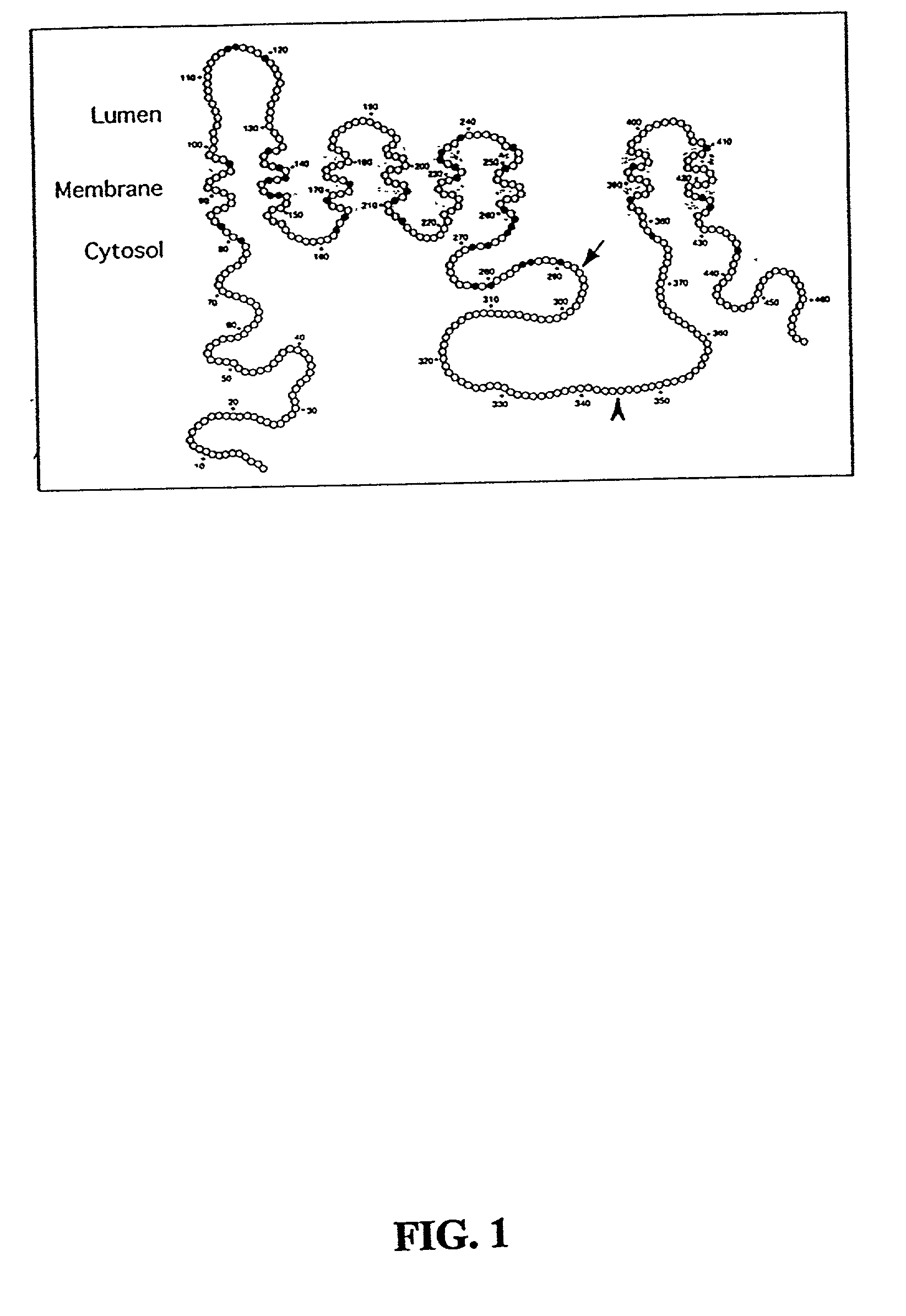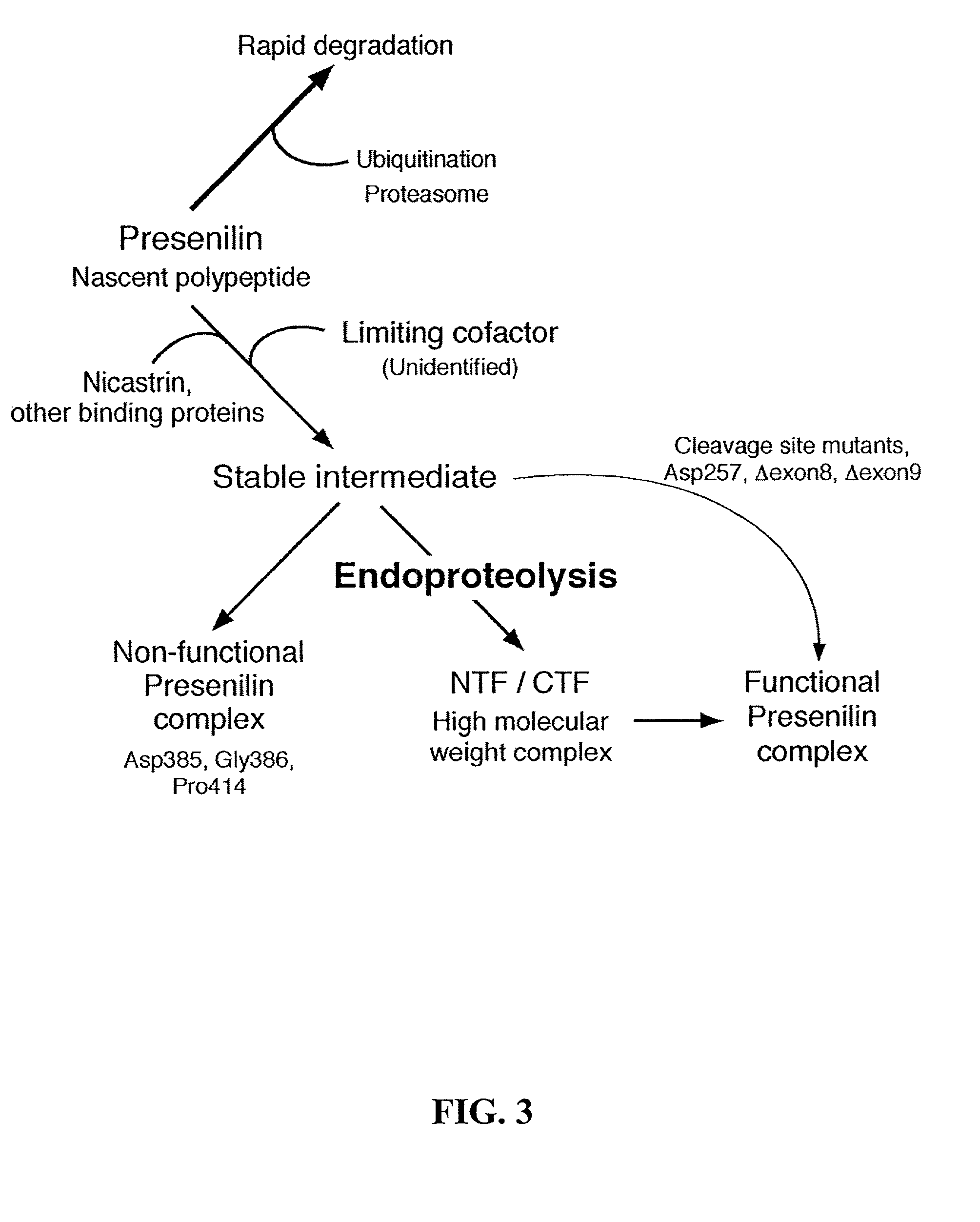Functional screening
a functional screening and functional technology, applied in the field of functional screening, can solve the problems of ad, ps1 critical for these biological functions, loss of all nervous functions, and little information regarding the molecular and structural domains of ps1
- Summary
- Abstract
- Description
- Claims
- Application Information
AI Technical Summary
Problems solved by technology
Method used
Image
Examples
example 1
Generation of Cell Lines
[0218] In cells transfected with unstable proteins a minor fraction of the unstable protein is processed into stable derivatives. Examples of unstable proteins are polytopic membrane proteins (i.e., multi-pass membrane proteins) with complex structure and / or "co-factors" such as ligand-gated ion channels (nicotinic acetylcholine receptors, GABA receptors, glycine receptors), and voltage gated ion channels (voltage-gated Na.sup.+ channels, K.sup.+ channels, and Ca.sup.2+0 channels); and PS proteins. For example, in transfected cells overexpressing PS, the vast majority of the synthetic PS polypeptides are rapidly degraded. Hence, stable cell lines were generated to assess the metabolism of the deletion mutants. These cell lines may further comprise one or more FAD mutations. The N2a cell line Swe. 10, which expresses human APP harboring the "Swedish" mutation is one of the cell lines used. These cells are particularly useful as they secrete easily-detectable l...
example 2
Functional Characterization of PS1 Chimeric Polypeptides
[0220] It is known that Presenilins (PS1 and PS2) are required for the intramembraneous cleavage of amyloid precursor protein (APP) and Notchl. To assess whether the chimeric PS1 polypeptides of the invention were functional APP and Notch processing was analyzed. PS1- fibroblasts were transfected with expression plasmids encoding chimeric PS1 molecules, along with a cDNA encoding APP or Notch1. Processing of APP was monitored by the secretion of beta-amyloid (A.beta.). Notch processing was monitored by the generation of Notch intracellular domain (NICD). Since PS1.sup.- / - fibroblasts completely lack PS1, they do not produce either A.beta. or NICD. Transfection with wild-type PS1 "rescued" this deficiency and both A.beta. and NICD were produced. The chimeric PS polypeptides of the invention, including PS1-Sh ble, PS-FP as well as the YFP-PS1-Sh ble, were equally efficient in rescuing A.beta. and NICD production in transfected PS...
example 3
Intramolecular Associations Between PS Transmembrane Domains
[0222] PS1 undergoes endoproteolytic processing in vivo to generate stable (t.sub.1 / 2.about.24 h) NTF and CTF. Co-immunoprecipitation and in situ cross-linking analyses of both cultured cells as well as intact brain tissue demonstrated that NTF and CTF derived from endoproteolytic processing of PS1 remain associated (Suzuki et al., 1994). Other studies also showed that transgene-derived human NTF fails to associate with endogenous mouse PS1 CTF (Tomita et al., 1999). PS proteins are known to form heteromeric assemblies and migrate as high molecular weight complexes on size exclusion columns and velocity density gradients (Seeger et al., 1997; Capell et al., 1998; Steiner et al., 1998). However, it was shown that cells co-expressing PS1 and PS2 do not form heteromeric PS1 / PS2 assemblies.
[0223] To characterize other intramolecular associations between PS transmembrane domains and to identify and characterize proteins that reg...
PUM
| Property | Measurement | Unit |
|---|---|---|
| volume | aaaaa | aaaaa |
| volume | aaaaa | aaaaa |
| concentration | aaaaa | aaaaa |
Abstract
Description
Claims
Application Information
 Login to View More
Login to View More - R&D
- Intellectual Property
- Life Sciences
- Materials
- Tech Scout
- Unparalleled Data Quality
- Higher Quality Content
- 60% Fewer Hallucinations
Browse by: Latest US Patents, China's latest patents, Technical Efficacy Thesaurus, Application Domain, Technology Topic, Popular Technical Reports.
© 2025 PatSnap. All rights reserved.Legal|Privacy policy|Modern Slavery Act Transparency Statement|Sitemap|About US| Contact US: help@patsnap.com



